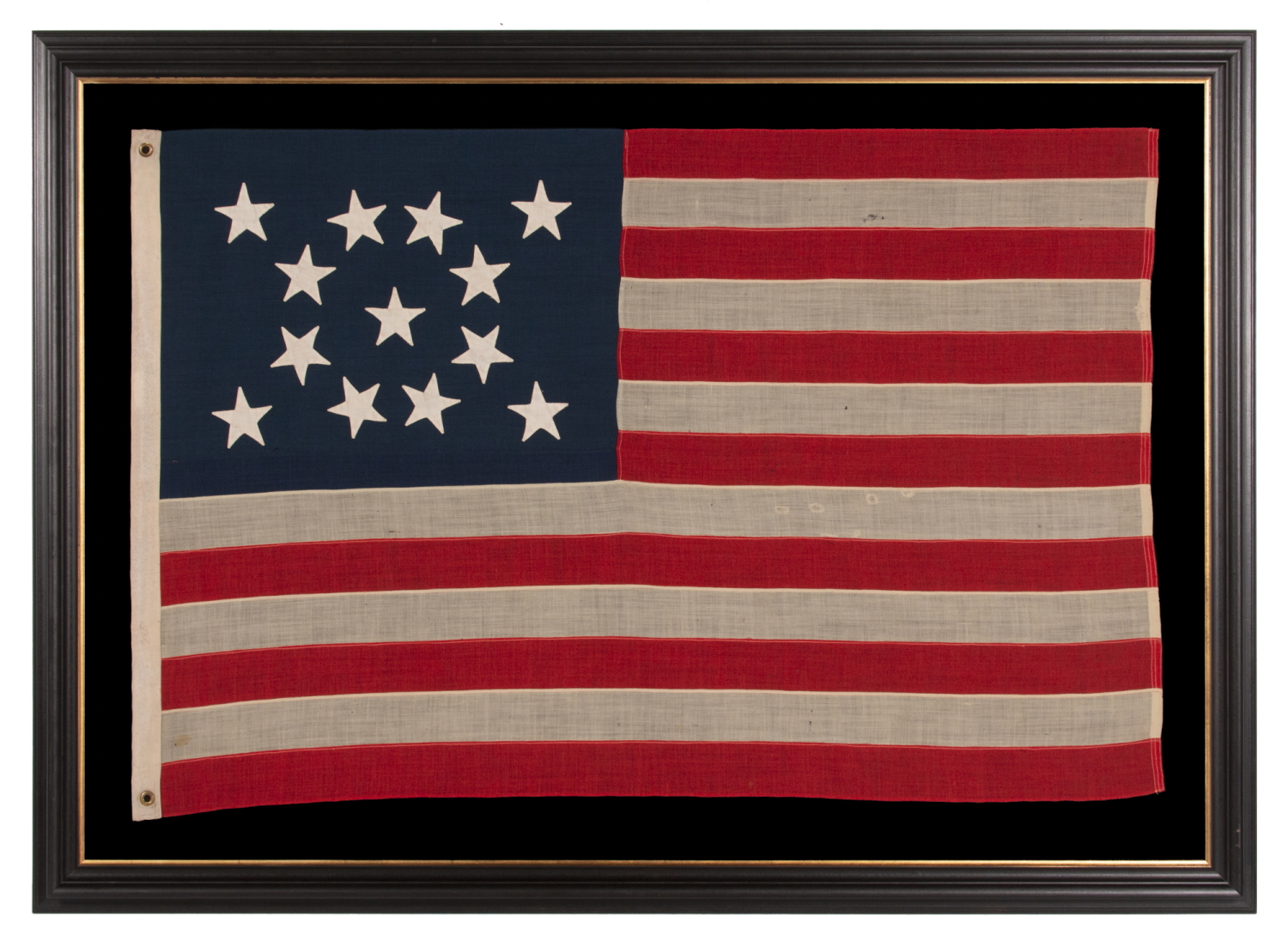
| |
13 STAR ANTIQUE AMERICAN FLAG, MADE IN THE ERA OF THE 1876 CENTENNIAL, WITH HAND-SEWN STARS IN A MEDALLION CONFIGURATION, IN A DESIRABLE SCALE AMONG ITS COUNTERPARTS OF THE PERIOD |
|
| Available: |
Sold |
| Frame Size (H x L): |
50.75" x 71" |
| Flag Size (H x L): |
38.5" x 59.5" |
|
| Description....: |
|
13 star American national flag, made in the era of the 1876 centennial of American independence, with beautifully hand-sewn stars. These are arranged in a medallion pattern that features a wreath of 8 stars, surrounding a single, center star, with a flanking star in each corner of the blue canton. This attractive design emerged during the Civil War and became very popular afterwards, especially on small, hand-held, printed flags, made for the celebration of our nation’s 100th anniversary. It is much more scarce, however, in flags of the centennial era with pieced-and-sewn construction, like this example.
The stars of the flag are made of cotton, hand-sewn, and double-appliquéd (applied to both sides). The canton and stripes of the flag are made of wool bunting that has been pieced and joined with treadle stitching. There is a twill cotton binding along the hoist with two brass grommets.
At just 5 feet on the fly, feet, the small scale of the flag versus its counterparts of the same period is very desirable. Prior to the last decade of the 19th century, most flags made for extended outdoor use were very large. Those with pieced-and-sewn construction were generally eight feet long and larger. This is because flags needed to be seen from a distance to be effective in their purpose as signals. Today their use is more often decorative and the general display of patriotism. Smaller flags exist in the early periods, but they are the exception as opposed to the rule. A six-foot example is small among those that pre-date 1890, and they smaller they are, the more unusual they are among surviving flags.
Why 13 Stars?
13 star flags have been continuously produced throughout our nation’s history for purposes both patriotic and utilitarian. This was the original number of stars on the American flag, representing the original 13 colonies, so it was appropriate for any flag made in conjunction with celebrations of American independence. In addition to use at the 1876 centennial, 13 star flags were hoisted at patriotic events, including Lafayette’s visit in 1824-25, the sesquicentennial in 1926, and celebrations of July 4th. They were displayed during the Civil War, to reference past struggles for American liberty, and were used by 19th century politicians, while campaigning, for the same reason.
As the number of stars grew with the addition of new states, it became more and more difficult to fit their full complement on a small flag. The stars would, by necessity, have to become smaller, which made it more and more difficult to view them from a distance as individual objects. The fear was that too many of them close together would become as one white mass and distort the ability to identify American ships on the open seas. Keeping the count low allowed for better visibility. For this reason the U.S. Navy flew 13 star flags on small boats. Private ship owners often mirrored Navy practice.
Flag experts disagree about precisely when the Navy began to revert to 13 stars and other low counts. Some feel that the use of 13 star flags never stopped, which seems to be supported by depictions of ships in period artwork. This was, of course, the original number of stars on the first American national flag, by way of the First Flag Act of 1777, and equal to the number of original colonies that became states. Any American flag that has previously been official remains so according to the flag acts, so it remains perfectly acceptable to fly 13 star flags today by way of congressional law.
Mounting: The flag was mounted and framed within our own conservation department, which is led by expert staff. We take great care in the mounting and preservation of flags and have framed thousands of examples.
The black-painted and hand-gilded molding, with a wide, sculptural, shaped profile, is Italian. The background is 100% cotton twill, black in color, that has been washed and treated for colorfastness. The glazing is U.V. protective acrylic (Plexiglas). Feel free to contact us for more details.
Condition: There is extremely minor mothing and extremely minor staining in very limited areas, accompanied by a slightly larger incidence of loss near the bottom center of the 1st white stripe, and six, small, early, darning repairs about ¾ of the way across the 3rd white stripe. The overall condition is simply exceptional for a wool flag of the period. |
|
|
|
| Collector Level: |
Advanced Collectors and the Person with Everything |
|
| Flag Type: |
Sewn flag |
|
| Star Count: |
13 |
|
| Earliest Date of Origin: |
1876 |
|
| Latest Date of Origin: |
1876 |
|
| State/Affiliation: |
13 Original Colonies |
|
| War Association: |
|
|
| Price: |
SOLD |
|
| |
Views: 878 |
|
|
|

